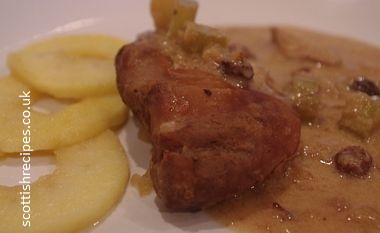Pheasant Casserole
Game bird stew using pheasant, casserole ingredients and cooking directions
A bird in abundance here in Aberdeenshire. This pheasant casserole recipe can be cooked in joints or whole:
Breakfast
Starters
Main Course
dethumps

Desserts/Snacks

Pheasant Casserole Recipe
Ingredients:
1 pheasant or 1.1kg pieces Buy online at Donald Russell or Campbells.
50g seedless raisins
15g flour
450mls water
150mls cider or white wine
65g butter
2 sticks of celery
small carrot
1 onion
2 cooking apples and 1 dessert apple
300mls of stock (improves the flavour if used from the giblets)
pinch of mixed spice
150ml yoghurt or cream
salt and pepper
Follow us on Twitter, Facebook, and Instagram.

The North-East of Scotland skies are under attack from an enemy jet. It is spilling a strange yellow smoke. Minutes later, people start killing each other.
Former Royal Air Force Regiment Gunner Jason Harper witnesses this and then his wife, Pippa, telephones him, shouting that she needs him. They then get cut off. He sets straight out towards Aberdeen, unprepared for the nightmare that unfolds during his journey. Everyone seems to want to kill him.
Along the way, he pairs up with fellow survivor Imogen. But she enjoys killing the living dead far too much. Will she kill Jason in her blood thirst? Or will she hinder his journey through this zombie filled dystopian landscape to find his pregnant wife?
The Fence is the first in this series of post-apocalyptic military survival thrillers from the torturous mind of Scottish horror and science fiction novel writer C.G. Buswell.
Download Now.
Buy the Paperback.

The 44 Scotland Street Cookbook recipes book is based on the character's favourite food from the series by Alexander McCall Smith. Written by Anna Marshall, and with Bertie, Big Lou and Domenica's help, you'll find Scottish favourites like Scotch Pies and Deep Fried Mars Bars along with international treats like Panforte di Siena.
Buy Now.
Recipe For Pheasant
1. Soak the raisins in the cider/wine for 2 hours.
2. Make stock from the giblets by simmering for about an hour with the carrot, a quarter of the onion and a wee piece of the celery. Sieve before using.
3. Peel/core the apple and slice. Chop the onion and celery finely.
4. Truss/Joint the pheasant, dust with flour and the salt, pepper and spice.
5. Melt the butter, add the pheasant and slowly cook to brown the bird, then drain and set aside.
6. Gently fry the onion for a few minutes, then add the celery and cooking apples and fry for a further 5 minutes.
7. Stir in the remaining flour and cook for a minute.
8. Add the raisins, stock and cider and bring to the boil.
9. Turn this and the bird into a pan, place the lid and simmer for one and a half hours or until the bird is lovely and tender.
10. Lift the bird/pieces out and set aside.
11. If the sauce in the pan is still liquidy then leave the lid off and boil for a wee bit longer to thicken. Add the yoghurt or cream and gently reheat. Pour into a serving dish.
12. Peel and core the dessert apple and slice into fine rings. Gently fry them in the butter and use to garnish.
More pheasant recipes include Breast of Pheasant with Orange and Ginger Sauce and also Walnut Coated Pheasant Breast Fillets.
If you like our Traditional Scottish Recipes and would like to easily share them with your friends and family please use the social networking buttons below:
Tweet

An army veteran moves his family back to Scotland, but his nightmare neighbour starts a battle of wits with him. Who will win this One Last War?
Buy this latest novel by Scottish author C.G. Buswell on Kindle or Paperback.
Advertise on Scottish Recipes Website Facebook and Twitter Pages from just £25.

Information About Pheasants
The Latin name for pheasants is Phasianus colchicusn torquatus in the order of Galliformes. There are 35 species in 11 different genera. They are attractive game birds noted for their large long tails. Males are characterised by strong sexual dimorphism and have rich chestnut, golden-brown and black markings on their body and tail, with a dark green head and red face wattling. Males are much larger than female birds. Females are mottled with paler brown and black.
They were introduced to the UK for sport shooting and are still bred for hunting. They tend to live in wooded areas, the open countryside, thickets, copses and hedgerows where they survive naturally on a diet of shoots, grain and seeds. Though they are found in most areas of Britain they are more prevalent in Scotland.
It has a distinctive kok kok kok call.
Pheasant shooting is a popular sport, especially in Scotland and Northern England and it is common for up to 300 birds to be shot during a shoot. Pheasant shooting season generally takes place from November and generally ends around the 1 February.
Events
Reviews
Chef Recipes
Scottish Food
Tunnock's
Flags/Emblem of Scotland
Favourite Places
Disclaimer Policy

